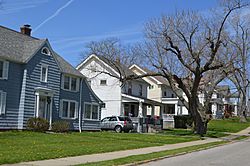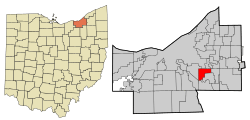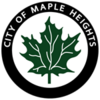Maple Heights, Ohio facts for kids
Quick facts for kids
Maple Heights, Ohio
|
|||
|---|---|---|---|

Residential neighborhood along Vine Street
|
|||
|
|||

Location in Cuyahoga County and the state of Ohio.
|
|||
| Country | United States | ||
| State | Ohio | ||
| County | Cuyahoga | ||
| Incorporated | 1915 | ||
| Government | |||
| • Type | Mayor-Council | ||
| Area | |||
| • Total | 5.17 sq mi (13.39 km2) | ||
| • Land | 5.17 sq mi (13.39 km2) | ||
| • Water | 0.00 sq mi (0.00 km2) | ||
| Elevation | 896 ft (273 m) | ||
| Population
(2020)
|
|||
| • Total | 23,701 | ||
| • Density | 4,585.22/sq mi (1,770.30/km2) | ||
| Time zone | UTC-5 (Eastern (EST)) | ||
| • Summer (DST) | UTC-4 (EDT) | ||
| ZIP code |
44137
|
||
| Area code(s) | 216 | ||
| FIPS code | 39-47306 | ||
| GNIS feature ID | 1048945 | ||
| Interstates | |||
| Rapid Transit | |||
| Website | https://www.citymapleheights.com/ | ||
Maple Heights is a city located in Cuyahoga County, Ohio, in the United States. It's a suburb, which means it's a town near a larger city, in this case, Cleveland. In 2020, about 23,701 people lived there.
Contents
History of Maple Heights
Maple Heights has an interesting past, from its early transportation to its shopping centers and recent financial improvements.
Early Transportation and Shopping
In 1935, the city started its own bus system called Maple Heights Transit. This helped people travel to Downtown Cleveland, around town, and to schools.
A very important shopping center, Southgate USA, opened in 1955. It was one of the first large shopping centers of its kind. It had over 80 stores, including popular ones like JCPenney and Sears. In 2002, a new bus station, the Southgate Transit Center, was built there. It connects many bus routes, making it easier for people to travel to different areas.
City Finances and Growth
In 2015, Maple Heights faced some money troubles. The state of Ohio declared the city was in a "fiscal emergency" because it had a large debt. However, the city worked hard to fix its finances. They made smart decisions about spending and budgeting.
By 2019, the city's money situation had greatly improved. In November 2020, the state announced that Maple Heights was no longer in a fiscal emergency. This was a big achievement for the city's leaders and residents.
Also in 2020, Governor Mike DeWine announced good news for jobs in Maple Heights. GOJO Industries, the company that makes Purell hand sanitizer, decided to open a factory in the city. This new factory was expected to create 100 new jobs for the community.
Geography of Maple Heights
Maple Heights is located in Ohio. The city covers a total area of about 5.17 square miles (13.39 square kilometers). All of this area is land, meaning there are no large lakes or rivers within the city limits.
Population and People
Maple Heights has seen its population change over the years. Here's a quick look at how many people have lived in the city:
- 1920: 1,732 people
- 1930: 5,950 people
- 1940: 6,728 people
- 1950: 15,586 people
- 1960: 31,667 people
- 1970: 34,093 people
- 1980: 29,465 people
- 1990: 27,089 people
- 2000: 26,156 people
- 2010: 23,138 people
- 2020: 23,701 people
Who Lives in Maple Heights?
In 2020, the city's population was 23,701. Most people in Maple Heights are African American, making up about 74.59% of the population. White residents make up about 18.24%. Other groups, including Asian, Native American, and people of mixed races, also live in Maple Heights. About 2.76% of the population is Hispanic or Latino.
In 2010, the average age of people in Maple Heights was 39.2 years old. About 25.1% of residents were under 18. Most households had families, with an average of 2.41 people per household.
Education in Maple Heights
Maple Heights has a public school system and a private school option for students.
Public Schools in Maple Heights
The public schools in Maple Heights are part of the Maple Heights City School District. A superintendent manages the district, and a board chosen by voters helps make decisions. The district has five schools:
- Abraham Lincoln School (Pre-Kindergarten to Grade 1)
- John F. Kennedy School (Grade 2 to Grade 3)
- Barack Obama School (Grade 4 to Grade 5)
- Milkovich Middle School (Grade 6 to Grade 8)
- Maple Heights High School (Grade 9 to Grade 12)
Private School in Maple Heights
- Castle High School - East is a public charter school located on Warrensville Center Road. It serves students in Grades 9 through 12.
Notable People from Maple Heights
Many interesting people have come from Maple Heights:
- Dale Mohorcic (born 1956) – A former baseball pitcher who played for the Texas Rangers.
- Mary Oliver (1935–2019) – A famous American poet who won a Pulitzer Prize for her work.
See also
 In Spanish: Maple Heights (Ohio) para niños
In Spanish: Maple Heights (Ohio) para niños



